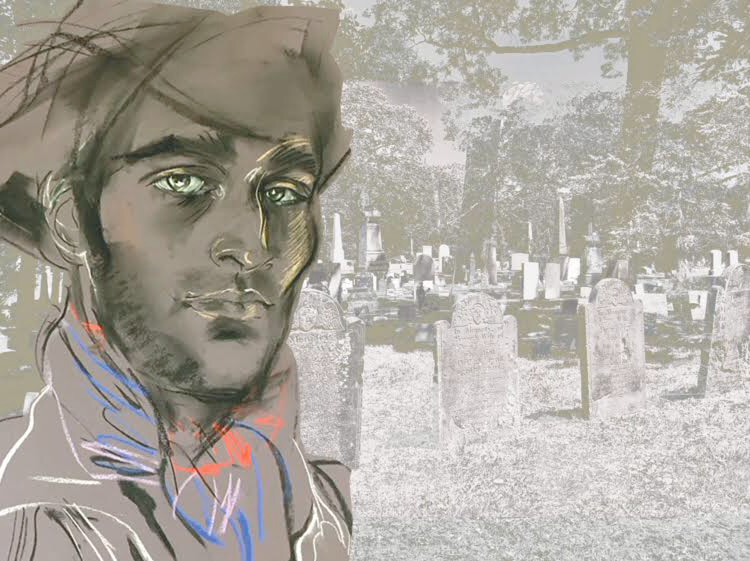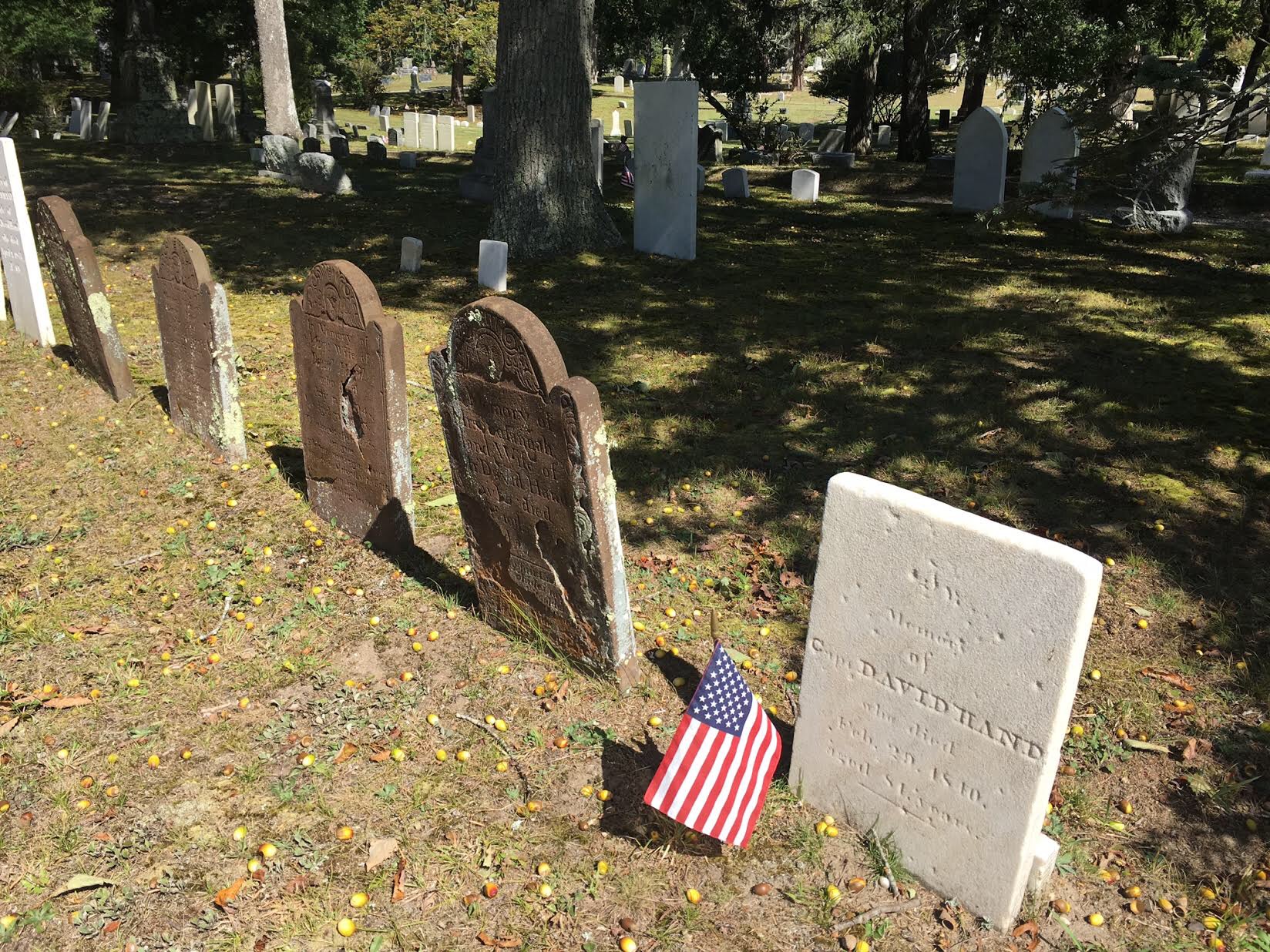
[caption id="attachment_73240" align="alignnone" width="750"] Captain David Hand, died 1840, age 81. Painting by Sabrina Streeter[/caption]
Captain David Hand, died 1840, age 81. Painting by Sabrina Streeter[/caption]
By Annette Hinkle
If you didn’t know any better, you’d think it was a story line from a mystery novel.
A legendary man in a small seaside community marries a young woman. That young woman soon dies, leaving the man a widower. So he finds and marries another young woman. But this bride, too, soon meets her demise, so the man takes a third wife, and …
Well, you can probably guess where this is all going.
In the end, Sag Harbor’s Capt. David Hand VI had five wives and outlived them all, marrying and then burying the first four in a span of less than 10 years. All four were under the age of 30. His fifth and final wife died in 1835 at the comparatively ripe old age of 69, and Capt. Hand was purportedly on the lookout for wife number six when he, himself died in 1840 at the age of 81.
The many brides and the man they married will come to life this weekend when the Sag Harbor Whaling and Historical Museum opens “The Five Wives of Captain Hand: A Maritime Melodrama by Artist Sabina Streeter.” The exhibition will feature pastel and charcoal portraits on sandpaper and linen of Capt. Hand, his wives, and other individuals central to his story, as envisioned by Ms. Streeter.
And when it comes to this story, there is much to envision.
Born in Sag Harbor in 1759, the travails and exploits of Capt. David Hand VI are well documented — in history and in fiction. A Revolutionary War hero, before he turned 20, he escaped British custody five times and became known as “Slippery Dave.” Apparently, he was so charismatic that in the “Leatherstocking Tales,” writer James Fennimore Cooper based his Natty Bumpo character on him.
Capt. Hand and his five wives lived in the tiny cottage across Church Street from the new Bulova townhouses. The Hand house is one of the oldest in Sag Harbor.
Originally built in Southampton sometime prior to 1732, it was moved to Sagaponack in 1752 and then Sag Harbor. A few years ago, the cottage itself made news due to damage it purportedly sustained during the construction process at Bulova.
While there is a great deal known about Capt. Hand and the house, the wives who lived with him there are, conversely, an entirely different matter. In the 17th and 18th century women’s stories typically didn’t register beyond their relationship to their husband, and the number and names of children they bore him.
“You lost your name once you were married,” notes Streeter.
[caption id="attachment_73239" align="alignnone" width="1024"] Capt. Hand's gravestone, far right, in the Oakland Cemetery. Annette Hinkle photo[/caption]
Capt. Hand's gravestone, far right, in the Oakland Cemetery. Annette Hinkle photo[/caption]
Other than their gravestones, which carry intriguing epitaphs, there is next to no information about the five wives — and certainly no photographs. So as an artist, Streeter took creative license in portraying all five as she imagined they might be.
“It’s almost like writing a script or something, and much of it’s based on lore where there’s really not that much proof,” explains Streeter. “It’s what people do. Moby Dick is based on the whale ship The Essex.”
As she has done in previous shows featuring portraits of historic whaling-era figures, if no paintings exist of the subject, Streeter seeks out models to portray the different characters, searching for individuals of the right age, often with the European features typical of the era or, in some cases, actual descendants of the people she is portraying in her work.
There’s also a certain look that Streeter tries to find in her models.
“In casting the models, if they have too contemporary a look, they don’t work. It’s great if there are existing portraits, which is super rare,” says Streeter, who has used a gallerist friend from St. Bart as a model, as well as another friend who’s a descendent of a Nantucket family.
“They typically come from English or Scottish heritage,” she says. “They also can have no face lift. There’s a certain quality of old fashioned features. When you go through their history, these people had a hard life and the model-y actress thing doesn’t work.”
In addition to the show at the Whaling Museum, now through the end of October, Streeter has several portraits of Connecticut mariners on view in “Stonington Portraits: A Seafaring Saga,” at the La Grua Center in Stonington, Connecticut.
The portraits she does of seafaring men and women are not intended to be historically accurate, but in many ways are a form of storytelling in their own right. For example, Streeter depicts one of Capt. Hand’s wives as a woman of mixed race, which allows her to illustrate that Sag Harbor was a cosmopolitan village populated by all sorts of nationalities and races, including Native Americans, free blacks and people from around the world.
When it comes to the truth of Capt. Hand and his five wives, one thing we can say for certain is that they are all together, lined up side by side in Oakland Cemetery, eternally defined by their chronological ranking. The first four wives — Susannah Sayre Stewart, her sister Mary Sayre Stewart, Hannah Miller and Charlotte Havens — are marked by identical sandstone headstones.
[caption id="attachment_73241" align="alignnone" width="768"] Susannah Sayre Stewart, the fourth wife of Capt. David Hand, as imagined by artist Sabrina Streeter.[/caption]
Susannah Sayre Stewart, the fourth wife of Capt. David Hand, as imagined by artist Sabrina Streeter.[/caption]
“Did he get a four for one deal?” muses Streeter. “It’s so cinematic in a way. They all died within a few years.”
Did he kill them? Perhaps that was a whispered theory among Sag Harbor’s residents during Capt. Hand’s time, but no documentation has been found to back up that theory.
Another rumor has it that wife number five, Hannah Sayre, outlived Capt. Hand and when he died, she had him buried face down to “stop his mischief making.”
But a trip to Oakland Cemetery quickly puts an end to that fake news.
The white marble gravestone of Hannah Sayre is situated next to wife number four, and clearly reveals she died five years before the captain. Her rectangular stone appears out of place as it is entirely different in both material and shape. Capt. Hand’s own rectangular marble gravestone, much like Hannah’s, sits at the other end of the wifely run, adjacent to bride number one.
Perhaps there are more secrets yet to be revealed about this tale and maybe folklorists, historians and artists like Sabina Streeter will one day find them.
For now, however, Capt. Hand and his five wives are giving up no details.
“The Five Wives of Captain Hand: A Maritime Melodrama by Artist Sabina Streeter” opens with a reception on Friday, October 7 from 6to 8 p.m, The exhibit runs until October 31 at the Sag Harbor Whaling & Historical Museum, 200 Main Street, Sag Harbor. Call 725-0770 for details or visit sagharborwhalingmuseum.org.